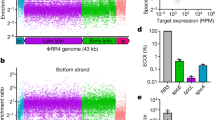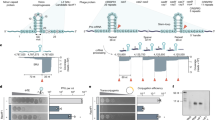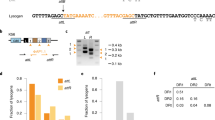Abstract
A widespread system used by bacteria for protection against potentially dangerous foreign DNA molecules consists of the clustered regularly interspaced short palindromic repeats (CRISPR) coupled with cas (CRISPR-associated) genes1. Similar to RNA interference in eukaryotes2, these CRISPR/Cas systems use small RNAs for sequence-specific detection and neutralization of invading genomes3. Here we describe the first examples of genes that mediate the inhibition of a CRISPR/Cas system. Five distinct ‘anti-CRISPR’ genes were found in the genomes of bacteriophages infecting Pseudomonas aeruginosa. Mutation of the anti-CRISPR gene of a phage rendered it unable to infect bacteria with a functional CRISPR/Cas system, and the addition of the same gene to the genome of a CRISPR/Cas-targeted phage allowed it to evade the CRISPR/Cas system. Phage-encoded anti-CRISPR genes may represent a widespread mechanism for phages to overcome the highly prevalent CRISPR/Cas systems. The existence of anti-CRISPR genes presents new avenues for the elucidation of CRISPR/Cas functional mechanisms and provides new insight into the co-evolution of phages and bacteria.
This is a preview of subscription content, access via your institution
Access options
Subscribe to this journal
Receive 51 print issues and online access
$199.00 per year
only $3.90 per issue
Buy this article
- Purchase on Springer Link
- Instant access to full article PDF
Prices may be subject to local taxes which are calculated during checkout


Similar content being viewed by others
References
Makarova, K. S. et al. Evolution and classification of the CRISPR-Cas systems. Nature Rev. Microbiol. 9, 467–477 (2011)
Makarova, K. S., Grishin, N. V., Shabalina, S. A., Wolf, Y. I. & Koonin, E. V. A putative RNA-interference-based immune system in prokaryotes: computational analysis of the predicted enzymatic machinery, functional analogies with eukaryotic RNAi, and hypothetical mechanisms of action. Biol. Direct 1, 7 (2006)
Brouns, S. J. J. et al. Small CRISPR RNAs guide antiviral defense in prokaryotes. Science 321, 960–964 (2008)
Rodriguez-Valera, F. et al. Explaining microbial population genomics through phage predation. Nature Rev. Microbiol. 7, 828–836 (2009)
Labrie, S. J., Samson, J. E. & Moineau, S. Bacteriophage resistance mechanisms. Nature Rev. Microbiol. 8, 317–327 (2010)
Jore, M. M., Brouns, S. J. J. & van der Oost, J. RNA in defense: CRISPRs protect prokaryotes against mobile genetic elements. Cold Spring Harb. Perspect. Biol. 4, http://dx.doi.org/10.1101/cshperspect.a003657 (2012)
Haurwitz, R. E., Jinek, M., Wiedenheft, B., Zhou, K. & Doudna, J. A. Sequence- and structure-specific RNA processing by a CRISPR endonuclease. Science 329, 1355–1358 (2010)
Deltcheva, E. et al. CRISPR RNA maturation by trans-encoded small RNA and host factor RNase III. Nature 471, 602–607 (2011)
Wiedenheft, B. et al. Structures of the RNA-guided surveillance complex from a bacterial immune system. Nature 477, 486–489 (2011)
Westra, E. R. et al. CRISPR immunity relies on the consecutive binding and degradation of negatively supercoiled invader DNA by Cascade and Cas3. Mol. Cell 46, 595–605 (2012)
Garneau, J. E. et al. The CRISPR/Cas bacterial immune system cleaves bacteriophage and plasmid DNA. Nature 468, 67–71 (2010)
Barrangou, R. et al. CRISPR provides acquired resistance against viruses in prokaryotes. Science 315, 1709–1712 (2007)
Yosef, I., Goren, M. G. & Qimron, U. Proteins and DNA elements essential for the CRISPR adaptation process in Escherichia coli. Nucleic Acids Res. 40, 5569–5576 (2012)
Cady, K. C., Bondy-Denomy, J., Heussler, G. E., Davidson, A. R. & O’Toole, G. A. The CRISPR/Cas adaptive immune system of Pseudomonas aeruginosa mediates resistance to naturally occurring and engineered phages. J. Bacteriol. 194, 5728–5738 (2012)
Marraffini, L. A. & Sontheimer, E. J. Self versus non-self discrimination during CRISPR RNA-directed immunity. Nature 463, 568–571 (2010)
Mojica, F. J. M., Diez-Villasenor, C., Garcia-Martinez, J. & Almendros, C. Short motif sequences determine the targets of the prokaryotic CRISPR defence system. Microbiology 155, 733–740 (2009)
Braid, M. D., Silhavy, J. L., Kitts, C. L., Cano, R. J. & Howe, M. M. Complete genomic sequence of bacteriophage B3, a Mu-like phage of Pseudomonas aeruginosa. J. Bacteriol. 186, 6560–6574 (2004)
Morgan, G. J., Hatfull, G. F., Casjens, S. & Hendrix, R. W. Bacteriophage Mu genome sequence: analysis and comparison with Mu-like prophages in Haemophilus, Neisseria and Deinococcus. J. Mol. Biol. 317, 337–359 (2002)
Datsenko, K. A. et al. Molecular memory of prior infections activates the CRISPR/Cas adaptive bacterial immunity system. Nature Commun. 3, 945 (2012)
Cady, K. C. & O’Toole, G. A. Non-identity-mediated CRISPR-bacteriophage interaction mediated via the Csy and Cas3 proteins. J. Bacteriol. 193, 3433–3445 (2011)
Battle, S. E., Meyer, F., Rello, J., Kung, V. L. & Hauser, A. R. Hybrid pathogenicity island PAGI-5 contributes to the highly virulent phenotype of a Pseudomonas aeruginosa isolate in mammals. J. Bacteriol. 190, 7130–7140 (2008)
Cady, K. C. et al. Prevalence, conservation and functional analysis of Yersinia and Escherichia CRISPR regions in clinical Pseudomonas aeruginosa isolates. Microbiology 157, 430–437 (2011)
Semenova, E. et al. Interference by clustered regularly interspaced short palindromic repeat (CRISPR) RNA is governed by a seed sequence. Proc. Natl Acad. Sci. USA 108, 10098–10103 (2011)
Zegans, M. E. et al. Interaction between bacteriophage DMS3 and host CRISPR region inhibits group behaviors of Pseudomonas aeruginosa. J. Bacteriol. 191, 210–219 (2009)
Heo, Y.-J., Chung, I.-Y., Choi, K. B., Lau, G. W. & Cho, Y.-H. Genome sequence comparison and superinfection between two related Pseudomonas aeruginosa phages, D3112 and MP22. Microbiology 153, 2885–2895 (2007)
Chung, I.-Y. & Cho, Y.-H. Complete genome sequences of two Pseudomonas aeruginosa temperate phages, MP29 and MP42, which lack the phage-host CRISPR interaction. J. Virol. 86, 8336 (2012)
Wang, P. W., Chu, L. & Guttman, D. S. Complete sequence and evolutionary genomic analysis of the Pseudomonas aeruginosa transposable bacteriophage D3112. J. Bacteriol. 186, 400–410 (2004)
Aziz, R. K. et al. The RAST server: rapid annotations using subsystems technology. BMC Genomics 9, 75 (2008)
Larkin, M. A. et al. Clustal W and Clustal X version 2.0. Bioinformatics 23, 2947–2948 (2007)
Altschul, S. F., Gish, W., Miller, W., Myers, E. W. & Lipman, D. J. Basic local alignment search tool. J. Mol. Biol. 215, 403–410 (1990)
Qiu, D., Damron, F. H., Mima, T., Schweizer, H. P. & Yu, H. D. PBAD-based shuttle vectors for functional analysis of toxic and highly regulated genes in Pseudomonas and Burkholderia spp. and other bacteria. Appl. Environ. Microbiol. 74, 7422–7426 (2008)
Acknowledgements
We thank D. Guttman, Y.-H. Cho, K. Cady and G. O’Toole for providing P. aeruginosa strains and phages. We also thank K. Severinov for providing the M13 phage and E. coli strains required for assaying the type 1-E system. We thank J. Brumell, A. Spence and W. Navarre for reading the manuscript. We also thank D. Bona for technical assistance. This work was supported by an Operating Grant to K.L.M. (fund number MOP- 6279) and an Emerging Team Grant to A.R.D. and K.L.M. (fund number XNE86943), both of which were from the Canadian Institutes for Health Research. J.B.D. was supported by a CIHR Canada Graduate Scholarship Doctoral Award.
Author information
Authors and Affiliations
Contributions
J.B.-D. designed experiments, performed experiments and wrote the manuscript, A.P. performed experiments, K.L.M. supervised experiments, and A.R.D. designed experiments and wrote the manuscript.
Corresponding author
Ethics declarations
Competing interests
The authors have filed a provisional patent pertaining to biotechnological applications of anti-CRISPR genes.
Supplementary information
Supplementary Information
This file contains Supplementary Figures 1-12, Supplementary Tables 1-2 and a Supplementary Reference. (PDF 3310 kb)
Supplementary Data
This file contains Supplementary Table 3 with a, Bacteria and Phage strain information, b, Primers used in this study and c, Plasmids which were constructed. (XLSX 19 kb)
PowerPoint slides
Rights and permissions
About this article
Cite this article
Bondy-Denomy, J., Pawluk, A., Maxwell, K. et al. Bacteriophage genes that inactivate the CRISPR/Cas bacterial immune system. Nature 493, 429–432 (2013). https://doi.org/10.1038/nature11723
Received:
Accepted:
Published:
Issue Date:
DOI: https://doi.org/10.1038/nature11723
This article is cited by
-
The zoonotic pathogen Wohlfahrtiimonas chitiniclastica – current findings from a clinical and genomic perspective
BMC Microbiology (2024)
-
Use of Cas9 Targeting and Red Recombination for Designer Phage Engineering
Journal of Microbiology (2024)
-
Bacteriophages suppress CRISPR–Cas immunity using RNA-based anti-CRISPRs
Nature (2023)
-
Complete genomes and comparative analyses of Streptomyces phages that influence secondary metabolism and sporulation
Scientific Reports (2023)
-
Anti-CRISPR proteins: a weapon of phage-bacterial arm race for genome editing
The Nucleus (2023)
Comments
By submitting a comment you agree to abide by our Terms and Community Guidelines. If you find something abusive or that does not comply with our terms or guidelines please flag it as inappropriate.



